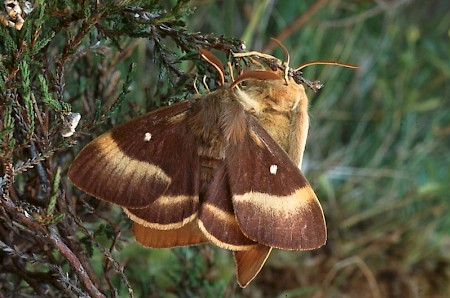66.007 BF1637
Oak Eggar Lasiocampa quercus
(Linnaeus, 1758)
Wingspan 45-75 mm.
The Oak Eggar, despite its name, does not feed on Oak, but is so-called because the shape of its cocoon is acorn-like. The foodplants are mainly heather (Calluna) and bilberry (Vaccinium myrtillus), but also include bramble (Rubus), Sallows (Salix), broom (Cytisus scoparius), sloe (Prunus spinosa), hawthorn (Crataegus), hazel (Corylus) and Sea-buckthorn (Hippophae rhamnoides).
The red-brown males fly during the day, especially in sunshine, whereas the larger, paler females are nocturnal and can be attracted to light. The normal flight period in lowland southern Britain is July to August, and in the north from late May to early July. Adults from northern moors, and some dunes and southern heaths, are often larger and darker than most southern forms.
In the north of Britain, development takes two years, in the south one year, with a zone in the Midlands and Welsh borders where it varies, probably with variation in the climate from year to year. Formerly, northern populations with a two-year cycle were given sub-specific status as the Northern eggar (Lasiocampa quercus callunae), but the situation is not as clear-cut as previously thought.
The larvae change considerably in appearance during development, and care should be taken not to confuse early instars with the larvae of other eggars (Trichiura, Eriogaster and Lasiocampa species). Fox moth (Macrothylacia rubi) and the Drinker (Euthrix potatoria) should be checked when identifying last instar larvae. Early instar larvae from moorlands are often duller, especially on the dorsum, than larvae from other habitats.
When the two-year cycle is followed, larvae usually live from July to the September of the following year, and pupae overwinter from September to May. One-year cycle larvae usually live from September to May, with pupae in June. Rearing larvae indoors can accelerate development.

 UKMoths
UKMoths 











